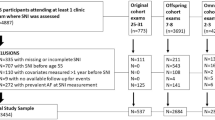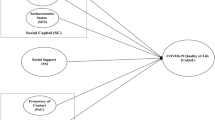Abstract
The aim of this study was to ascertain the relationship between social network and the appearance of mortality (cardiovascular events (CVEs)) in patients with arterial hypertension (AHT). This is a cohort study of 236 patients with a 9-year follow-up. Measurements included age, sex, blood pressure (BP), diabetes, hypercholesterolemia, marital status, social network, social support, stage of family life cycle (FLC), mortality and CVEs. Patients with a low social network registered higher global mortality (hazards ratio (HR) 2.6 (95% confidence interval (CI) 1.3; 5.5)) as did the oldest patients (HR 5.6 (1.9; 16.8)), men (HR 3.5 (95% CI 1.3; 9.3)) and subjects in the last FLC stages (HR 4.3 (95% CI 1.3;14.1)). Patients with low social support registered higher cardiovascular mortality (HR 2.6 (95% CI 1.1; 6.1)) as did the oldest patients (HR 12.4 (95% CI 2.8; 55.2)) and those with diabetes (HR 3.00 (95% CI 1.2; 7.6)). Patients with a low social network registered more CVEs (HR 2.1 (95% CI 1.1; 4.1)) than patients with an adequate network, as did the oldest patients (HR 3.1 (95% CI 1.4; 6.9)), subjects who presented with a higher grade of severity of AHT (HR 2.7 (1.3; 5.5)) and those in the last FLC stages (HR 2.5 (95% CI 1.0; 6.2)). A low social network is associated with mortality and the appearance of CVEs in patients with AHT. Low functional social support is associated with the appearance of cardiovascular mortality.
This is a preview of subscription content, access via your institution
Access options
Subscribe to this journal
Receive 12 digital issues and online access to articles
$119.00 per year
only $9.92 per issue
Buy this article
- Purchase on Springer Link
- Instant access to full article PDF
Prices may be subject to local taxes which are calculated during checkout



Similar content being viewed by others
References
Croezen S, Picavet HS, Haveman-Nies A, Verschuren WM, de Groot LC, van't Veer P . Do positive or negative experiences of social support relate to current and future health? Results from the Doetinchem Cohort Study. BMC Public Health 2012; 12: 65.
Berkman L, Syme L . Social networks, host resistance and mortality: a nine-year follow-up study of Alameda county residents. Am J Epidemiol 1979; 109: 186–204.
Petersson L, Hedblad B, Janzon L, Östergren P . Social support and behavior in a stressful situation in relation to myocardial infarction and mortality: who is at risk? Results from prospective cohort study “Men born in 1914”, Malmö, Sweden. Int J Behav Med 2006; 13 (4): 340–347.
Prince MJ, Harwood RH, Blizard RA, Thomas A, Mann AH . Social support deficits, loneliness and life events as risk factors for depression in old age. The Gospel Oak Project VI. Psychol Med 1997; 27: 323–332.
Fortmann AL, Gallo LC . Social support and nocturnal blood pressure dipping: a systematic review. Am J Hypertens 2013; 26 (3): 302–310.
Barth J, Schneider S, von Känel R . Lack of social support in the etiology and the prognosis of coronary heart disease: a systematic review and meta-analysis. Psychosom Med 2010; 72 (3): 229–238.
Rosengren A, Hawken S, Ôunpuu K, Zubaid M, Almahmeed W, Blackett K et al. Association of psychosocial risk factors with risk of acute myocardial infarction in 11119 cases and 13648 controls from 52 countries (the INTERHEART study): case-control study. Lancet 2004; 364: 953–962.
Menéndez C, Montes A, Gamarra T, Núñez C, Alonso A, Buján S . Influencia del apoyo social en pacientes con hipertensión arterial esencial. Aten Primaria 2003; 31: 506–513.
Bellón JA, Delgado A, de Dios LJ, Lardelli P . Validez y fiabilidad del cuestionario de apoyo social funcional Duke-UNC-11. Aten Primaria 1996; 18 (4): 153–163.
Blake R, McKay D . A single-item measure of social supports as a predictor of morbidity. J Fam Pract 1986; 22: 82–84.
Piñeiro F, Gil V, Orozco D, Pastor R, Merino J . Validez de 6 métodos indirectos para valorar el cumplimiento del tratamiento farmacológico en la hipertensión arterial. Aten Primaria 1997; 19: 372–375.
De La Revilla L . Conceptos e Instrumentos de la Atención Familiar. Doyma: Barcelona, Spain, 1994.
Bellón JA, Delgado A, Luna J, Lardelli P . Validez y fiabilidad del cuestionario de función familiar Apgar-familiar. Aten Primaria 1996; 18: 289–296.
Banegas JR . Epidemiología de la hipertensión arterial en España. Situación actual y perspectivas. Hipertensión 2005; 22 (9): 353–362.
Coca A . Evolución del control de la hipertensión arterial en atención primaria en España. Resultados del estudio Controlpres 2003. Hipertensión 2005; 22 (1): 5–14.
Ferrando J, Nebot M, Borrell C, Egea L . Apoyo social y estado de salud percibido población no institucionalizada de más de 60 años. Gac Sanit 1996; 10: 174–182.
Fernández AM, Bujalance MJ, Leiva F, Martos F, Crespo AJ, García AJ et al. Salud autopercibida, apoyo social y familiar de los pacientes con enfermedad pulmonar obstructiva crónica. Medifam 2001; 11: 530–539.
Eng P. M, Rimm EB, Fitzmaurice G, Kawachi I . Social ties and change in social ties in relation to subsequent total and cause-specific mortality and coronary heart disease incidence in men. Am J Epidemiol 2002; 155 (8): 700–709.
Lobos Bejarano JM, Royo-Bordonada MA, Brotons C, Alvarez-Sala L, Armario P, Maiques A et al. [European Guidelines on Cardiovascular Disease Prevention in Clinical Practice. CEIPC 2008 Spanish Adaptation]. Aten Primaria. 2009; 41 (8): 463.e1–463.e24.
Kawachi I, Colditz G, Ascherio A, Rimm E, Giovannucci E, Stampfer M et al. A prospective study of social networks in relation to total mortality and cardiovascular disease in men in the USA. J Epidemiol Community Health 1996; 50: 245–251.
Russek L, Schwartz G . Perceptions of paternal caring predict health status in midlife: a 35- year follow-up of the Harvard Mastery of Stress Study. Psychosom Med 1997; 59: 144–149.
Jenkinson CM, Madeley RJ, Mitchell RA, Turner ID . The influence of psychosocial factors on survival after myocardial infarction. Public Health 1993; 107: 305–317.
Ruberman W, Weinblatt E, Goldberg J, Chaudhary B . Psychosocial influences on mortality after myocardial infarction. N Engl J Med 1985; 311: 552–559.
Seeman T, Syme L . Social networks and coronary artery disease: a comparison of the structure and function of social relations as predictors of disease. Psychosom Med 1987; 49: 341–354.
Krumholz H, Butler J, Miller J, Vaccarino V, Williams C, Mendes de León C et al. Prognostic importance of emotional support for elderly patients hospitalized with heart failure. Circulation 1998; 97: 958–964.
Berkman L, Leo-Summers L, Horwitz R . Emotional support and survival after myocardial infarction. Ann Intern Med 1992; 117: 1003–1009.
Zenarutzabeitia A, Rodriguez JJ, López M . Atención a la familia. In: Casado Vicente Verónica y Colaboradores. Tratado de Medicina de Familia y Comunitaria Vol II. Semfyc Ediciones: Barcelona, Spain, 2007, 1783–1825.
Dickens CM, McGowan L, Percival C, Douglas J, Tomenson B, Cotter L et al. Lack of a close confidant but no depression, predicts further cardiac events after IAM. Heart 2004; 90: 518–522.
Schoenbach V, Kaplan B, Fredman L, Kleinbaum D . Social ties and mortality in Evans County, Georgia. Am J Epidemiol 1986; 123: 577–591.
Orth-Gomer K, Johnson JV . Social network interaction and mortality. J Chronic Dis 1987; 40: 949–957.
Wellin L, Svardsudd K, Ander-Peciva S, Tibblin G, Tibblin B, Larsson B . Prospective study of social influences on mortality. Lancet 1985; 20: 915–918.
Yasuda N, Zimmerman SI, Hawkes W, Fredman L, Hebel JR, Mazinger J . Relation of social network characteristics to 5-year mortality among young-old versus old-old white women in an urban community. Am J Epidemiol 1997; 145 (6): 516–523.
Nebot M, Lafuente J, Tomás Z, Borrell C, Ferrando J . Efecto protector del apoyo social en la mortalidad en población anciana: un estudio longitudinal. Rev Esp Salud Pública 2002; 76: 673–682.
Hanson B, Isacsson S, Janzon L, Lindell S, Rastam L . Social anchorage and blood pressure in elderly men -a population study. J Hypertens 1988; 6: 503–510.
Penninx BW, van Tilburg T, Kriegsman DM, Deeg DJ, Boeke AJ, van Eijk JT . Effects of social support and personal coping resources on mortality in older age: the Longitudinal Aging Study Amsterdam. Am J Epidemiol 1997; 146 (6): 510–519.
Seeman T, Berkman LF, Kohout F, Lacroix A, Glynn R, Blazer DG . Intercommunity variation in the association between social ties and mortality in the elderly: a comparative analysis of three communities. Ann Epidemiol 1993; 3: 325–335.
Hu HH, Li G, Arao T . The association of family social support, depression, anxiety and self-efficacy with specific hypertension self-care behaviours in Chinese local community. J Hum Hypertens (e-pub ahead of print 10 July 2014; doi:10.1038/jhh.2014.58).
Bell CN, Thorpe RJ Jr, Laveist TA . Race/ethnicity and hypertension: the role of social support. Am J Hypertens 2010; 23 (5): 534–540.
Moyer VA . Behavioral counseling interventions to promote a healthful diet and physical activity for cardiovascular disease prevention in adults: U.S. Preventive Services Task Force Recommendation Statement. Ann Intern Med 2012; 157: 367–372.
Rees K, Bennett P, West R, Davey SG, Ebrahim S . Psychological Interventions for Coronary Heart Disease (Cochrane Review). Update Software: Oxford, UK, 2004.
Acknowledgements
We thank Dr Joaquín Cubiella Fernández for his help with the drafting of this manuscript. This work was funded by Health Research Fund grant FIS 96/1480 (Fondo de Investigación Sanitaria) from Spain’s Ministry of Health and Consumer Affairs and by a doctoral thesis grant from the Spanish Society of Family and Community Medicine (Sociedad Española de Medicina Familiar y Comunitaria—Semfyc) in 2005.
Author information
Authors and Affiliations
Corresponding author
Ethics declarations
Competing interests
The authors declare no conflict of interest.
Rights and permissions
About this article
Cite this article
Menéndez-Villalva, C., Gamarra-Mondelo, M., Alonso-Fachado, A. et al. Social network, presence of cardiovascular events and mortality in hypertensive patients. J Hum Hypertens 29, 417–423 (2015). https://doi.org/10.1038/jhh.2014.116
Received:
Accepted:
Published:
Issue Date:
DOI: https://doi.org/10.1038/jhh.2014.116
This article is cited by
-
Social vulnerabilities as risk factor of childhood obesity development and their role in prevention programs
International Journal of Obesity (2021)
-
Social Networks and Health Outcomes: Importance for Racial and Socioeconomic Disparities in Cardiovascular Outcomes
Current Cardiovascular Risk Reports (2018)



